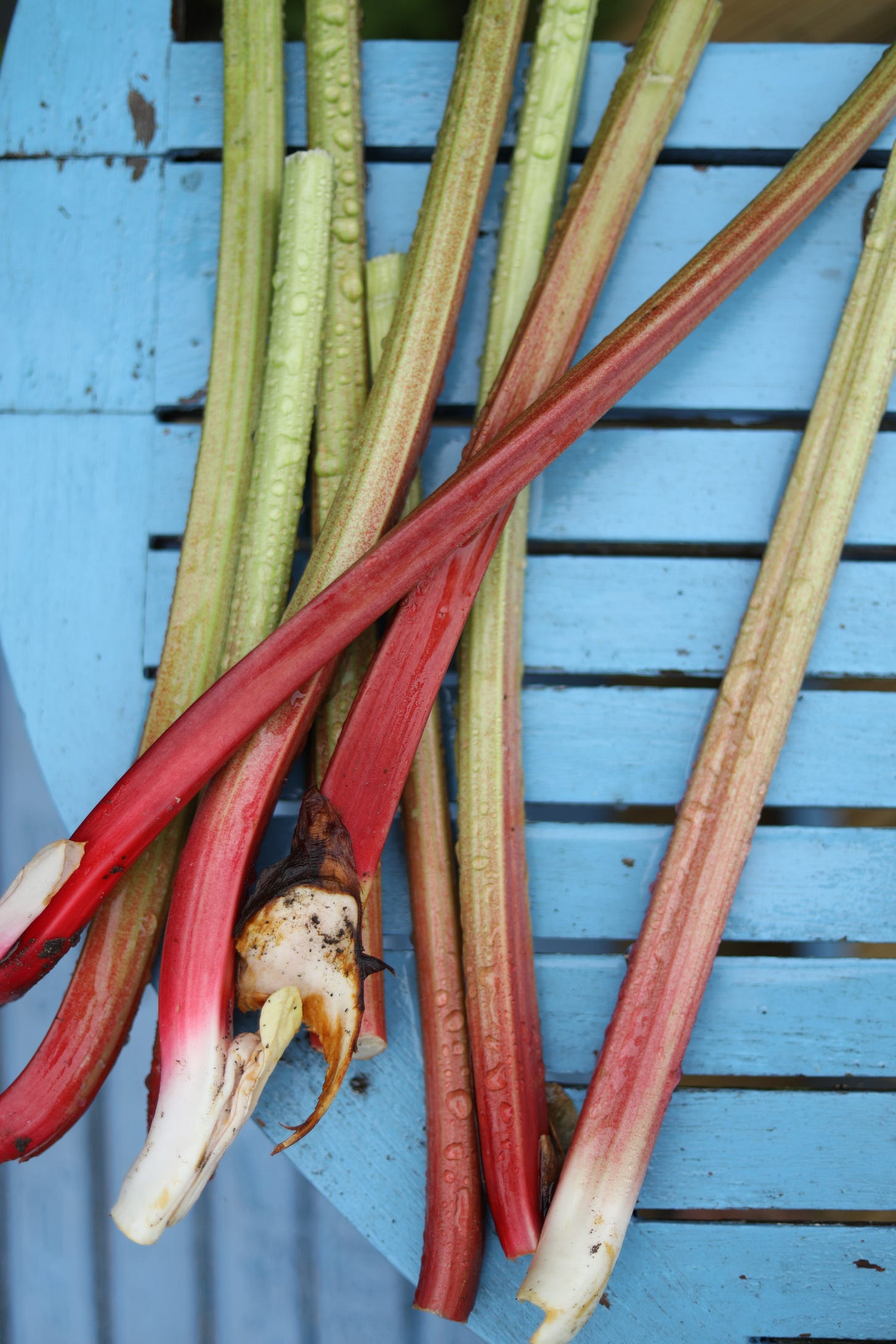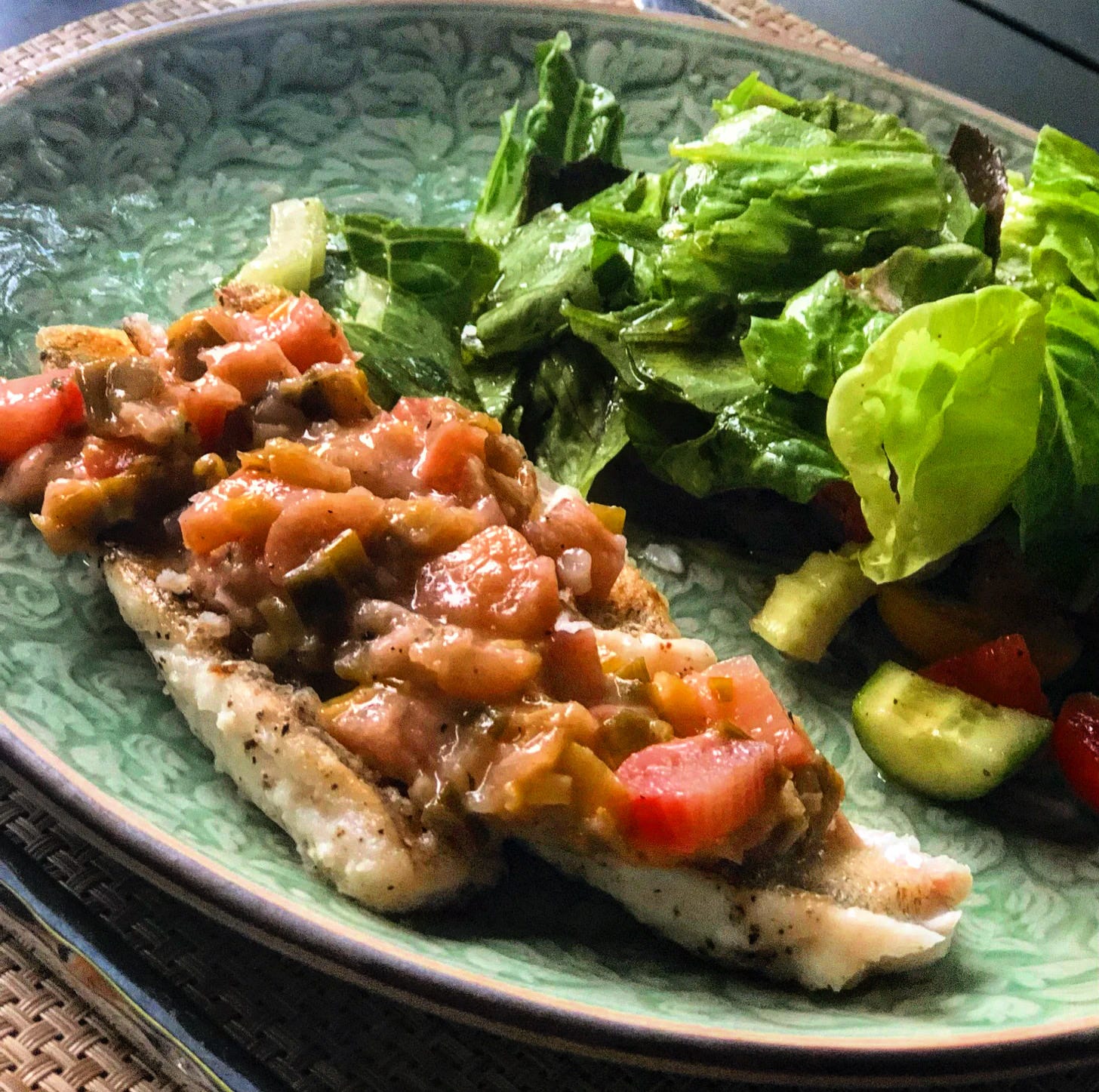A short and selective history of rhubarb
and a trio of rhubarb recipes that take you beyond the dessert course
Of the many heralds of spring, rhubarb holds the queen’s crown in my heart.
Tart, crisp, long and colourful, rhubarb spreads like a weed, grows in the most inhospitable conditions, puts up with neglect, allows us to force it into existence and generally tolerates our bad behaviour.
Cut into a fresh stalk and you are rewarded with the indefinable scent of spring: green and fresh, sharp yet subtle, a whiff of freshly cut grass and a promise of good things.
Rooted in medicine, harvested by candlelight

Rhubarb fans are legion, nowhere more so than in Britain and North America, where this humble plant has found its way onto the dessert course for hundreds of years. But rhubarb didn’t start its journey as a compote, cake, cordial or jam.
The Chinese first discovered rhubarb’s astringency to be effective as a laxative. Ancient Greeks and Romans carried on rhubarb’s medicinal tradition, and gave rhubarb its modern name. Rhubarb derives from the Latin rhabarbarum – rheum, the plant genus of which rhubarb is a cultivar, and barbarum, the Latin for barbarian.
It wasn’t until the 1800s that rhubarb’s culinary prowess came to the fore. According to Dennis Duncan of High Altitude Rhubarb, widespread consumption of rhubarb began in Britain in the early 19th century, growing in popularity as an ingredient in desserts and wine making. With a short growing season, the discovery that rhubarb could be “forced” (grown out of season in the winter), caused its popularity to reach fever pitch, peaking just before World War II.
And this is where the most romantic part of rhubarb’s history comes into play.
The rhubarb triangle
In long dark barns across a small patch of West Yorkshire, a great agricultural tradition continues. This is the “rhubarb triangle,” a nine-square-mile area between Wakefield, Morley and Rothwell. Here, from January to March, fuchsia-pink forced rhubarb, prized for its subtle flavour, is picked by hand, by candlelight, so that the delicate stems are not turned green and hard by photosynthesis.
from Mysteries of the Rhubarb Triangle, The Guardian
Forcing is not the exclusive domain of rhubarb. Greenhouses, cold frames, and hotbeds have long been used to satisfy our thirst for delicious things that are not “in season”. An advocate for buying asparagus in May and tomatoes in August, I’m not usually in a hurry to get something before Mother Nature delivers it. Yet the decidedly romantic Rhubarb Triangle in England makes the practice more palatable.
Forced rhubarb from the Triangle once made up nearly 90% of winter rhubarb. While the quantities are far lower today, Yorkshire’s fuchsia-pink, delicately flavoured stalks are still prized for making ruby-coloured treats. Still harvested today by candlelight to keep the stalks red, you can experience this delicacy at Wakefield’s annual Rhubarb Festival. Now that’s out of season eating I can get behind.
A trio of rhubarb recipes
If you are a rhubarb fan, you’ll have had your fair share of rhubarb-strawberry desserts, perhaps a compote, or a rhubarb ginger jam. You may have made rhubarb muffins, a mixed fruit galette, a “blubarb” pie. If rhubarb were in school, the teacher might say it “plays well with others.” Rhubarb is the kitchen’s equivalent of the movie sidekick: reliable, consistent, but always in the background, never the star performer.
It’s true that rhubarb is a wonderful companion to many fruits, its puckery tartness softened with plenty of sugar, but that really does give rhubarb short shrift. That indescribable scent and taste come to life in a savoury guise too. Try this trio of recipes to bring rhubarb to every part of the meal.
(ps. And if you want a killer rhubarb dessert, click here to see my updated recipe for the best rhubarb upside down cake EVER).
Rhubarb shrub for cocktail hour
from Lynn Crawford’s Farm to Chef
Rather than waiting for dessert, why not start your evening with the delicious taste of rhubarb? Lynn Crawford’s rhubarb shrub shines in a gin cocktail (see recipe below), but can also make a beautiful alternative to a mimosa for brunch or jazz up sparkling water for a seasonal mocktail. The best part is that the shrub keeps well in the refrigerator for several weeks.
Rhubarb Shrub
4 cups rhubarb, chopped into ½ inch pieces
2 strips lemon zest
2 inch piece fresh ginger, peeled and thinly sliced
2 cups granulated sugar
2 cups white vinegar
Combine the rhubarb, lemon zest, ginger, sugar and vinegar in a heavy bottomed saucepan. Bring to the boil, reduce heat and simmer gently for 30 – 40 minutes, stirring occasionally, until the fruit is soft.
Set a sieve over a large bowl. Pour the rhubarb through the sieve and leave to drain without pressing the fruit (or you will cloud the shrub). Carefully pour syrup into a sterilized bottle, cover and refrigerate. It will keep for up to one month.
Ruby’s Ginny Rhubarb Fizz
Serves 1
1 ounce rhubarb shrub
2 ounces London dry gin
Soda water
Lemon wedge
In a rocks or Collins glass, stir the rhubarb shrub and gin, add ice, top with soda water, squeeze in a lemon wedge stir and enjoy!
Easy pickled rhubarb
Anna Jones, from The Guardian
Makes 1 litre
For the next course, why not have a simple rhubarb pickle on hand? It keeps for weeks, and works whenever you might use a chutney or a pickle. Also good tossed through salads, on top of roast vegetables or as a partner for cheese. You will need enough sterilised jars (and lids) to hold 1 litre of the rhubarb.
1 pound pink rhubarb, stalks separated and washed
1 small thumb fresh ginger (about ½ ounce), peeled and chopped into thin matchsticks
2 bay leaves
2 tsp black peppercorns
2 tsp black mustard seeds
1 cup red wine vinegar
¾ cup light brown or Demerara sugar
½ tsp salt
Cut the rhubarb into ½ inch pieces and pack it into the jars with the ginger, bay leaves and spices.
In a small saucepan, bring the red wine vinegar, 1 cup water, sugar and salt to a boil, whisking to dissolve. Once the liquid has come to a boil and the sugar has dissolved, take the pan off the heat.
Leave the liquid to cool slightly for just a couple of minutes, then carefully pour it over the rhubarb; it should cover it completely. If you are short, top up with some boiled water. Close immediately with sterilised lids.
Leave to cool before storing in the fridge. Let the rhubarb pickle cure for at least 48 hours before eating, then enjoy within three weeks of opening.
Rhubarb leek butter
from the Inn on the Twenty Cookbook, Michael and Anna Olsen
This rhubarb-leek butter is fabulous on grilled fish, pork chops or lamb. It can be whipped up in minutes and any leftover butter stores beautifully in the freezer. What could be better than having rhubarb butter at your fingertips year round? No forcing required.
1 tablespoon unsalted butter
2 leeks, white and light green part only, sliced and well washed
2 cups fresh rhubarb, diced
½ cup white wine
¼ cup sugar
½ cup unsalted butter, cut into small pieces
One sprig of fresh thyme, finely chopped
Salt and pepper
Heat a small sauce pan over medium heat. Add 1 tablespoon butter and leeks, and sauté leeks until tender, around five minutes.
Add rhubarb, white wine and sugar and simmer until liquid is reduced by half, about 15 minutes. Add remaining half cup butter, a piece at a time, until all of it is incorporated.
Add thyme and season with salt and pepper to taste. Serve alongside grilled fish or meats.








Well recipe number one Is going to be a huge hit - especially with ME. And number three sounds delish and a must-try…
I love the sound of pickled rhubarb!